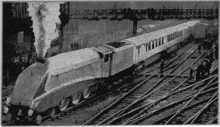Silver Jubilee (train)
 The Silver Jubilee train leaving King's Cross on 27 September 1935 on a trial run north during which it attained a record speed of 112 miles per hour (180 km/h) | |
| Overview | |
|---|---|
| Service type | Passenger train |
| First service | 30 September 1935 |
| Former operator(s) |
London and North Eastern Railway British Rail |
| Route | |
| Start | London King's Cross |
| End | Newcastle |
| Service frequency | Daily |
| Line(s) used | East Coast Main Line |
The Silver Jubilee was a named train of the London & North Eastern Railway (LNER).
History
It commenced service on 30 September 1935, the train travelling between London King's Cross and Newcastle. It did this at an average speed of 67 mph (108 km/h), taking four hours to complete the journey.[1] The high average speed was maintained by running at high speeds uphill. [2]
The train was made in the year of King George V's Silver Jubilee, and was painted silver throughout. It was composed of two twin-set articulated coaches, and one triple-set; seven coaches in all.
The train set a new standard for speed in Britain, at that time. Service continued until the outbreak of the Second World War in 1939.[3]
Technical details
Engine and train: total length 462 ft 2 3⁄8 in (140.88 m) Total weight: 385 long tons (391 t; 431 short tons).[4]
Revival
The name was briefly applied to one train per day between King's Cross and Edinburgh Waverley in 1977 for the Silver Jubilee of Elizabeth II.
See also
References
- ↑ "New Train's Fast Run". Hull Daily Mail. England. 30 September 1935. Retrieved 19 September 2017 – via British Newspaper Archive. (Subscription required (help)).
- ↑ "LNER "The Silver Jubilee" Train" (PDF). The Engineer. England. 27 September 1935.
- ↑ Silver Jubilee (6 December 1935). Railway Wonders of the World. Amalgamated Press. pp. 1436–1442.
- ↑ L.N.E.R. The Silver Jubilee. The Locomotive Publishing Co.